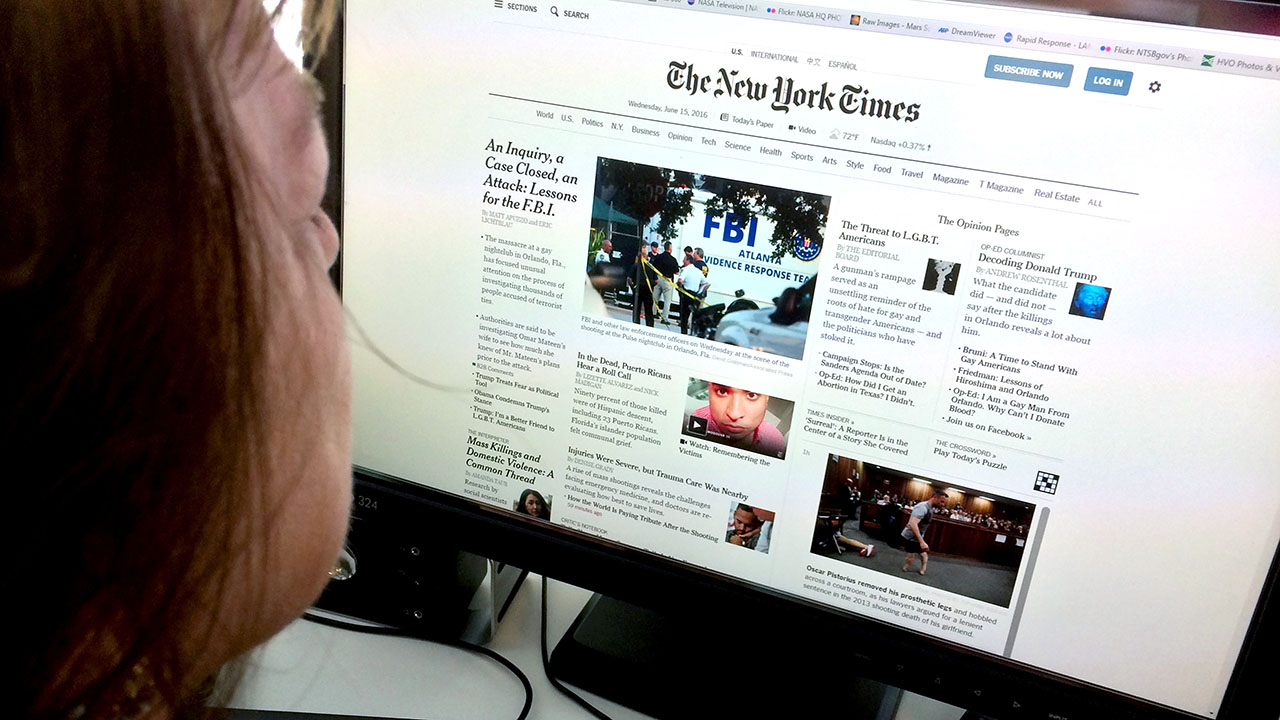The Insider’s Checklist for Following stnews.live Every Day
The Influence of Social Network en route We Take In News Online
Social media site has basically changed news consumption. It provides instant access to information, frequently eclipsing traditional media outlets. This fast circulation comes with difficulties. Individuals deal with the danger of coming across misinformation and becoming entraped in resemble chambers. The algorithms driving individualized material can cover varied perspectives. As these characteristics advance, understanding their effects comes to be essential for notified engagement in public discourse. What strategies might help navigate this facility landscape?
The Evolution of News Consumption in the Digital Age
As innovation advanced, the method people eaten news transformed substantially in the digital age (stnews.live). Traditional newspapers and broadcast media began to decrease as the internet became a main source of details. On the internet platforms supplied instantaneous access to news articles, videos, and podcasts, enabling individuals to stay notified at any time. The benefit of smart phones better increased this change, making it possible for customers to get updates on the move
Additionally, the rise of news aggregators and internet sites facilitated the intake of diverse viewpoints, encouraging users to customize their news consumption based on personal interests. This evolution likewise triggered wire service to adjust their approaches, focusing on electronic material and appealing viewers with multimedia styles. As a result, the traditional obstacles of time and space in news shipment lessened, bring about a more immediate and individualized news experience for target markets worldwide.
The Duty of Social Media Site Operatings Systems in News Circulation
Social media platforms have changed news circulation by offering instant access to info. Their algorithm-driven content curation commonly focuses on interaction over accuracy, resulting in considerable reliability obstacles (stnews.live). As customers browse this landscape, the implications for news usage and public discussion become progressively complex
Instantaneous News Access
Although traditional news electrical outlets have actually long been the key resource of info, the rise of social media sites platforms has actually substantially transformed how news is accessed and consumed. Instantaneous news accessibility has actually ended up being a trademark of the electronic age, enabling customers to obtain updates in actual time. Systems such as Twitter, Facebook, and Instagram allow news to spread out swiftly, frequently surpassing standard media in speed and reach. Customers can share tales, talk about occasions, and engage with journalists, creating a dynamic communication between the target market and news content. This immediacy fosters a society of urgency, prompting customers to inquire promptly. Subsequently, the assumption for timely news has reshaped journalistic techniques, engaging news companies to adjust their approaches to fulfill the demands of a busy digital setting.
Algorithm-Driven Web content
While customers actively engage with content on social media sites, the formulas that govern these systems play a crucial duty in determining which news stories acquire exposure. These formulas examine individual habits, preferences, and interaction metrics to curate tailored news feeds. As an outcome, certain tales may be amplified while others continue to be odd, frequently focusing on sensational or trending subjects over substantive coverage. This discerning direct exposure shapes customers' understandings of current occasions and influences public discussion. The reliance on algorithm-driven material can create echo chambers, where users are primarily subjected to perspectives that straighten with their very own beliefs. The characteristics of news distribution on social media systems substantially affect just how people eat and interpret details in the digital age.
Integrity Challenges
As individuals significantly transform to social networks for news, the integrity of details come across on these systems comes to be a pushing concern. The decentralized nature of social media sites permits anyone to release material, typically blurring the lines in between trustworthy journalism and false information. Formulas prioritize interaction over accuracy, causing the prevalent circulation of sensational or misleading stories. This atmosphere poses significant challenges for customers trying to determine credible resources. Social media platforms, while venturing to battle false information through fact-checking and web content small amounts, face objection for variances and prejudices in their approaches. Ultimately, the duty exists with customers to seriously assess the news they consume, as the fast spread of information commonly outpaces confirmation initiatives by platforms.
The Rise of Person Journalism and User-Generated Material
The increase of citizen journalism has equipped daily individuals to share news and viewpoints, typically offering insights that traditional media might neglect. This shift also provides considerable difficulties, particularly the spread of misinformation that can emerge from unproven content. As user-generated material ends up being more prevalent, the equilibrium in between genuine voices and accuracy in coverage remains a critical problem.
Encouraging Daily Voices

Difficulties of False information
While the rise of person journalism has opened methods for varied voices in the media landscape, it has actually additionally presented significant difficulties connected to false information. The ease of sharing information with social networks systems permits people to share news promptly, yet this fast spread usually comes with the price of precision. User-generated content often does not have the extensive fact-checking and editorial oversight that traditional journalism offers. Sensationalized or false narratives can gain grip, misguiding audiences and forming public assumption. In addition, the blending of viewpoint and truth within social media makes complex the distinction between trustworthy information and false information. As an outcome, consumers need to navigate an increasingly intricate media environment, needing vital believing abilities to determine reputable news sources amidst the sound

Misinformation and Its Implications for Public Discourse
As social media platforms increasingly control the landscape of details dissemination, the expansion of false information postures significant difficulties for public discussion. Misinformation, usually created to misguide or Find Out More prompt psychological actions, can misshape perceptions of fact and undermine trust fund in credible resources. This phenomenon causes polarized point of views, as individuals are attracted in the direction of resemble chambers that strengthen their ideas, even more setting departments within society.
The implications for public discussion are extensive. When residents rely upon false details, significant discussion lessens, and the autonomous procedure experiences. Misinformation can prompt anxiety and confusion, affecting public health, security, and political stability. As an outcome, promoting media literacy comes to be necessary, encouraging people to critically review info and discern fact from fiction. Resolving the difficulties presented by false information is important for protecting the honesty of public discussion and making sure a knowledgeable population efficient in participating in positive conversations.
The Impact of Formulas on News Exposure
Offered the central function of formulas in determining content exposure, their influence on news usage is extensive. These formulas, made use of by social networks systems, focus on particular sorts of material based upon user involvement and preferences. Consequently, newspaper article that align with prominent trends or target market interests are most likely to be presented plainly, while much less mind-blowing tales may be forgotten. This develops a setting where customers are revealed mostly to information that reinforces their point of views, possibly resulting in echo chambers.
Furthermore, the constant evolution of algorithms means that news companies have to adapt their techniques to straighten with these transforming specifications, frequently prioritizing clickbait or mentally billed headlines. The integrity of news reporting can be endangered, as critical stories might not receive the presence they should have. The mathematical shaping of news presence for that reason plays a crucial duty in influencing public perception and understanding of current events.
The Shift Towards Aesthetic Storytelling in News Media
Progressively, news media is welcoming aesthetic storytelling as an effective tool to engage target markets. This approach leverages photos, videos, infographics, and interactive elements to communicate info much more effectively than traditional text-based layouts. As focus extends reduce, visuals provide a fast, impactful means to connect intricate tales and get hold of audiences' rate of interest.
Systems like Instagram and TikTok have additional increased this pattern, engaging wire service to adjust their material methods to fit these visually-driven settings. By incorporating engaging visuals, news news outlets can enhance emotional connections and foster greater understanding of topical concerns.
Aesthetic narration allows for more diverse stories, showcasing several viewpoints via dynamic discussions. As audiences significantly consume news via mobile tools, the shift toward visuals not just accommodates customer preferences but likewise assists to damage down barriers to info gain access to. Ultimately, this evolution mirrors a more comprehensive makeover in exactly how news is generated and consumed in the electronic age.
Future Fads: Navigating the Altering Landscape of News Intake
While the electronic landscape remains to develop, news usage is poised for substantial transformation driven by arising modern technologies and changing audience actions. As synthetic knowledge and device discovering advancement, personalized news feeds will certainly come to be a lot more widespread, allowing customers to get content tailored to their interests. This modification could bring about better interaction but additionally increase issues about echo chambers and misinformation.
Furthermore, the increase of voice-activated devices and clever audio speakers will certainly influence how news is provided, changing the emphasis from aesthetic to acoustic styles. This pattern may motivate news organizations to embrace more succinct and interesting audio material.

Frequently Asked Concerns
Just How Do Social Network Communications Affect News Reputation?
Social media interactions can significantly affect assumptions of news reliability. Involvement metrics, such as likes and shares, frequently form target market trust, with popular articles getting perceived legitimacy, no matter of the precision or dependability of the details presented.
What Function Do Influencers Play in Shaping News Narratives?
Influencers substantially shape news narratives by leveraging their platforms to intensify specific tales, often customizing content to their audience. This can cause prejudiced viewpoints, impacting public understanding and focusing on sensationalism over accurate coverage.
How Can Users Identify Reliable News Resources on Social Media?
Customers can determine reputable news sources on social media sites by examining the source's reliability, validating realities through multiple outlets, assessing the professionalism and trust of the material, and identifying possible prejudices in reporting to ensure precise info.
What Impact Does Social Media Site Carry Traditional Journalism Jobs?
Social network considerably influences standard journalism work by altering profits versions, minimizing demand for print media, and cultivating competition from person journalists. Many professionals face work insecurity and should adapt to rapidly transforming media landscapes.
Just How Do Different Demographics Consume News on Social Media?
Different demographics show varied choices for news intake on social media. More youthful target markets favor systems like TikTok and Instagram for fast updates, while older people have a tendency to favor Facebook and Twitter for extra extensive conversations and posts.